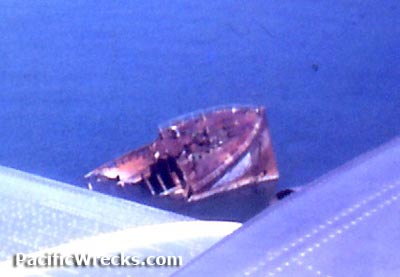|
|
|
|
| Missing In Action (MIA) | Prisoners Of War (POW) | Unexploded Ordnance (UXO) |
| Chronology | Locations | Aircraft | Ships | Submit Info | How You Can Help | Donate |
|
| Mine Layer Cargo 6,843 Tons 435' x 58' 5" x 32' 8" Deck Guns  USN March 10, 1942  3rd BG January 7, 1943  Unknown 1964  Albert Cross 1965 |
Ship History Built by Mitsubishi Shipbuilding at Nagasaki. On July 3, 1934 laid down down as a cargo vessel purchased by Toyo Kisen K. K. in Tokyo. Launched January 22, 1935 as Tenyo Maru. Completed March 28, 1935 and afterwards chartered to Mitsui Ltd. for use as a cargo ship providing freight service to ports in the United States, Soviet Union and Venezuela. Wartime History On September 9, 1941 requisitioned by the Imperial Japanese Navy (IJN). On September 15, 1941 arrives Harima shipyard and converted into a mine layer and armed with a deck gun with the conversion completed October 31, 1941. Registered in the Kure Naval District. Captain Ishido Yuzo is appointed Commanding Officer and assigned to the Fourth Fleet, Mine Division 19 along with minelayer Okinoshima and Tokiwa. On November 15, 1941 departs Kure. On December 3, 1941 with Okinoshima arrives Jaluit Atoll and three days later embarks troops then departs with Okinoshima and Nagata Maru. On December 8, 1941 at the start of the Pacific War departs at 1:0pm assigned to Operation Gi the invasion of the Gilbert Islands transporting the 51st Guards Unit with minelayers Tsugaru and Tokiwa escorted by Asanagi and Yunagi with Chitose Kokutai (Chitose Air Group) planes providing air cover. On December 10, 1941 at 12:45am with Okinoshima arrives off Makin and disembarks Special Naval Landing Force (SNLF) troops and secures the island. Meanwhile, Nagata Maru enters Makin Lagoon and unloads construction materials for a seaplane base completed two days later. On December 14, 1941 Tenyo Maru unloads aviation fuel to Nagata Maru and later in the day departs for Roi arriving two days later. On December 20, 1941 transfers aviation fuel to minelayer Tsugaru for air operations. On December 24, 1941 departs Roi for Wake Island arriving two days later then returns to Roi. On January 4, 1942 at 6:00am departs Roi for Truk arriving three days later. On January 9, 1942 departs Truk for Guam arriving two days later then departs. On January 12, 1942 returns to Guam and departs two days later. On January 20, 1942 loaded with airfield construction materials and is assigned to Operation R and departs bound for Rabaul. On January 23, 1942 at 2:25pm anchors off Rabaul. On February 25, 1942 embarks troops for Operation SR the invasion of Lae and Salamaua on New Guinea. On March 5, 1942 at 1:00pm departs Rabaul as part of a convoy including China Maru plus Kongo Maru, Kokai Maru and Yokohama Maru escorted by Kinryu Maru bound for New Guinea. Two days later, enters the Huon Gulf. On March 8, 1942 begins unloading at Lae. Sinking History On March 10, 1942 in the morning off Lae targeted by U.S. Navy (USN) SBD Dauntless dive bombers from Scouting Squadron 2 (VS-2) of USS Lexington (CV-2). At 8:44am hit by two bombs that result in nine crew killed. Damaged, the ship was deliberately run aground in an attempt to save the vessel with the bow facing the shore off the eastern edge of Lae Airfield. Tenyo Maru sank at roughly Lat 6° 49S, Long 147° 02E. On April 1, 1942 officially removed from the Navy list. Shipwreck The bow section of the ship to the forward king posts remained above the surface off the eastern edge of Lae Airfield. The rear section from the funnel to stern was below the surface. Until at least 1965, the bow of the ship was still visible above the water. Today the shipwreck is roughly 100 meters off the Lae Yacht Club. In the 1970s the visible part of the wreck slipped underwater after an earthquake. Underwater, the shipwreck is intact and upright little coral growth. The bow is at a depth of 33' / 10m and the stern at a depth of 131' / 40m. A portion of the bow section is broken off from the bridge. Diving the shipwreck is only recommended only for experienced SCUBA divers. The shipwreck is covered with mud and extreme care must be made to penetrate inside the vessel where mines are visible and a deck gun is on the bow. References Note, many references claim the Tenyo Maru broke into two halves when hit by the two bombs, this is incorrect. Lloyds of London Lloyd's Register of Ships - Tenyo Maru Lloyds of London Lloyd's Register of Ships - Tenyo Maru 1934-1935 [PDF] NARA Task Force 11 "Report of attack on enemy forces at Salamaua-Lae Area, 3/10/42" March 25, 1942 pages 1-45 (report), 46-128 (photos) CombinedFleet - IJN Auxiliary Minelayer TENYO MARU Tabular Record of Movement Naval History and Heritage Command (NHHC) Japanese Naval and Merchant Shipping Losses page 30 (Tenyo Maru), 120 (index Tenyo Maru) Thanks to Lang Kidby for additional information Contribute
Information |
10-40m Photo Archive |
| Discussion Forum | Daily Updates | Reviews | Museums | Interviews & Oral Histories |
|